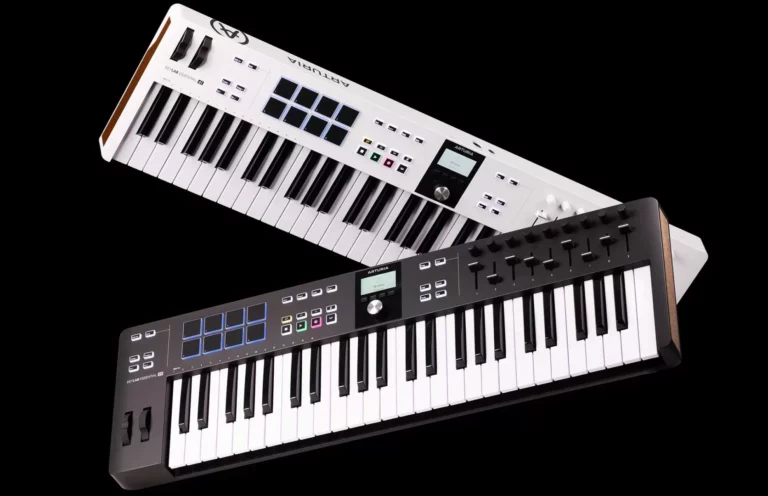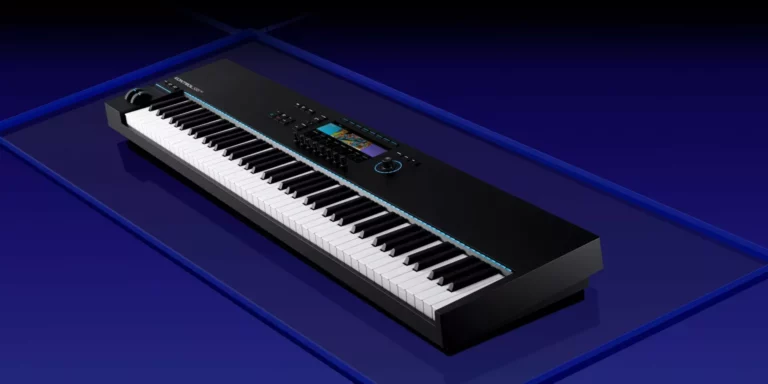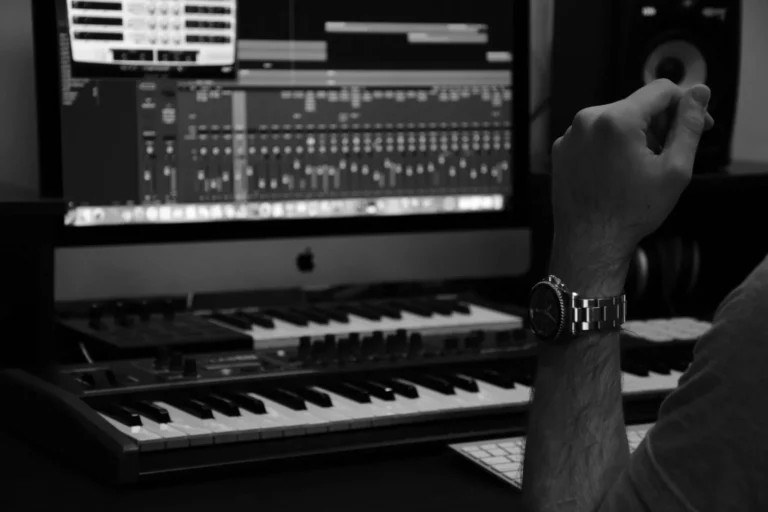
The Korg microKORG XL+ Synthesizer/Vocoder is a versatile and powerful instrument that embodies the perfect fusion of vintage sounds and modern innovation.
With its sleek design, expanded PCM, and an impressive array of features, the microKORG XL+ ensures that musicians and producers have hands-on control with one of Korg’s best synthesizers and endless fun with unique and interesting sounds.
Related Posts:
The Korg Krome 88 Review: An Affordable Workstation Synth
The Korg Kross 88: Ultimate Synth Review In 2023
Yamaha MODX and MODX+ Full Review: Best Synths In 2023
MicroKorg XL+ Synthesizer Expert Review: Best Korg Synths
Contents
- MicroKorg XL+ Synthesizer Expert Review: Best Korg Synths
- Design
- Sound and Performance
- Vocoder and Vocal Effects
- Editing and Customization
- Connectivity
- Comparisons
- FAQ
- 1. Is the Korg MicroKORG XL+ Suitable for Beginners?
- 2. Does the Korg MicroKORG XL+ Come With Preset Sounds?
- 3. What Type of Batteries Does the Korg MicroKORG XL+ Require?
- 4. Is the Gooseneck Microphone Included With the Korg MicroKORG XL+?
- 5. Can the MicroKORG XL+ Be Integrated Into a Music Production Setup?
- Conclusion
Design
There is no doubt that the Korg Microkorg is an awesome piece of kit. It is aesthetically pleasing, robust, and built with portability in mind.
This 37-key synthesizer and vocoder is compact and yet does not compromise on quality, making it ideal for musicians on the go.
Its sleek design, paired with a user-friendly interface, allows for ease of navigation through its various unique sounds, ensuring that creativity flows uninterrupted. It has a retro, 70’s/80’s all-black design, which helps make this a standout synth.
Uniquely, the Microkorg XL+ has an inbuilt 16-band vocoder with an XLR gooseneck mic. The mic has a formant hold and formant shift features. Korg included their proprietary natural touch mini-keyboard, designed with an emphasis on synth playability!
Sound and Performance
When it comes to sound, the Korg microKORG XL+ excels in versatility.
The expanded PCM, which is a significant feature, offers an extensive range of sounds, including the “SGproX” piano, “M1” and “VOX organ,” allowing for a more diverse and rich sonic experience.
Its sound engine ranges from classic to modern sounds making it a go-to option for multiple genres of music. . A powerful Kaoss effects engine is also included.
Vocoder and Vocal Effects

The vocoder functionality in the Microkorg XL+ is a standout feature, elevating vocal processing and manipulation possibilities.
Coupled with the gooseneck microphone, musicians have the flexibility to explore, create, and express their musical ideas innovatively and uniquely.
Editing and Customization
The Microkorg XL+ ensures that customization is at the forefront, allowing users to tweak and tailor sounds according to their preferences and project needs.
The editing features are intuitive, ensuring that even those who are relatively new to synthesizers can navigate and utilize the available functionalities with ease.
Connectivity

Connectivity is uncomplicated in the Korg microKORG XL+.
It is equipped with various connection ports such as USB and MIDI, enhancing its compatibility and integration with other equipment and software, which is crucial for modern music production and performance setups.
Also, if you are keen on purchasing a Microkorg, be sure to get a good case like the one below, to protect your new synth!
Comparisons
Microkorg XL+ vs Microkorg
Design
MicroKorg
- Compact and lightweight design.
- Classic retro look with a small interface.
- 37 mini-keys that may be less comfortable for some players.
- Limited real-time controls on the front panel.
MicroKorg XL+
- Slightly larger and heavier than the MicroKorg.
- Modern and sleek design with a larger interface.
- 37 natural touch keys for a more comfortable playing experience.
- More dedicated knobs and controls on the front panel, enhancing real-time tweaking.
Sound and Controls
MicroKorg
- Based on MMT (Multi Modeling Technology).
- Four voices of polyphony.
- Limited to two oscillators per voice.
- Classic virtual analog synthesis with some limitations on sonic complexity.
- LCD screen for parameter visualization.
- Single multifunction knob for programming.
MicroKorg XL+
- Upgraded sound engine
- Increased polyphony (up to eight voices).
- Offers more versatility and depth in sound design.
- Improved overall sound quality with a wider sonic palette.
- More hands-on controls on the front panel, reducing the need for excessive menu diving.
- Larger display for better parameter visibility.
- Dedicated knobs for various functions, making sound editing more intuitive.
Presets and Connectivity
MicroKorg
- Comes with a variety of factory presets, but user customization is somewhat constrained.
- Standard MIDI in/out, audio in, and headphone out.
- USB for MIDI.
MicroKorg XL+
- Expanded preset storage.
- More factory presets and greater user customization capabilities.
- Similar connectivity options as the MicroKorg.
- USB port for MIDI.
Microkorg vs Minilogue
Sound Engine
- MicroKorg: Classic monophonic with versatile virtual analog synthesis.
- Minilogue: Polyphonic, known for warm, lush tones.
Polyphony
- MicroKorg: Monophonic.
- Minilogue: Polyphonic (four voices on the original model).
Controls and Interface
- MicroKorg: Compact design, some menu diving.
- Minilogue: Hands-on interface, direct control with knobs.
Effects
- MicroKorg: Built-in effects like delay and flanger.
- Minilogue: Includes effects like delay; variations exist between models.
Keyboard
- MicroKorg: 37-note mini-keyboard.
- Minilogue: 37-note full-size keyboard.
Portability
- MicroKorg: Highly portable and budget-friendly.
- Minilogue: Slightly larger but still portable.
Check out the full review of the Korg Minilogue below:
Korg Minilogue & Mini-XD Synthesizers: The Best Mini Synths?
Korg Microkorg vs Novation Mininova
Sound Engine
- MicroKorg: Virtual analog synthesis, classic monophonic sound with versatile emulation.
- MiniNova: Virtual analog with wavetable synthesis, and polyphonic capabilities for more diverse soundscapes.
Polyphony
- MicroKorg: Monophonic.
- MiniNova: Polyphonic, enabling simultaneous play of multiple notes.
Controls and Interface
- MicroKorg: Compact design, limited hands-on controls, some menu diving.
- MiniNova: More extensive controls with a larger front panel, offering easier real-time parameter adjustments.
Effects
- MicroKorg: Built-in effects like delay and flanger.
- MiniNova: Extensive effects section with modulation options, enhancing sound customization.
Keyboard
- MicroKorg: 37-note mini-keyboard.
- MiniNova: 37-note mini-keyboard.
Korg Microkorg vs Korg Monologue
Sound Engine
- MicroKorg: Virtual analog synthesis, monophonic, known for versatile classic sounds.
- Monologue: Analog synthesis, monophonic, designed for bass and lead sounds with a focus on modern tones.
Polyphony
- MicroKorg: Monophonic.
- Monologue: Monophonic, optimized for monophonic play and sequence creation.
Controls and Interface
- MicroKorg: Compact design with limited controls, some menu diving for parameter adjustment.
- Monologue: Streamlined interface with dedicated knobs and switches for immediate hands-on control.
Effects
- MicroKorg: Built-in effects like delay, and flanger.
- Monologue: Limited built-in effects, but the focus is on creating raw analog tones.
Keyboard
- MicroKorg: 37-note mini-keyboard.
- Monologue: 25-note mini-keyboard.
Korg Monologue Synth: The Best Monophonic Synth in 2023?
FAQ
1. Is the Korg MicroKORG XL+ Suitable for Beginners?
Yes, its user-friendly interface and straightforward editing features make it accessible for beginners, while its extensive functionalities will also satisfy more advanced users.
2. Does the Korg MicroKORG XL+ Come With Preset Sounds?
Yes, it comes with a variety of preset sounds, allowing users to explore and use them creatively in their projects.
3. What Type of Batteries Does the Korg MicroKORG XL+ Require?
The microKORG XL+ can be operated using AA alkaline batteries, making it convenient for mobility and performance.
4. Is the Gooseneck Microphone Included With the Korg MicroKORG XL+?
Yes, the gooseneck microphone, essential for utilizing the vocoder functionalities, is included in the package.
5. Can the MicroKORG XL+ Be Integrated Into a Music Production Setup?
Yes, its connectivity options, such as USB and MIDI ports, allow for easy integration into a digital audio workstation (DAW) environment.
Conclusion
The Korg microKORG XL+ 37-Key Synthesizer/Vocoder with Expanded PCM is a powerhouse of features and functionalities packed into a compact and portable design.
Its capacity to deliver a diverse range of sounds, combined with easy-to-use editing features and robust vocoder functionality, makes it an exceptional choice for musicians, producers, and synthesizer enthusiasts.
Related Posts:



